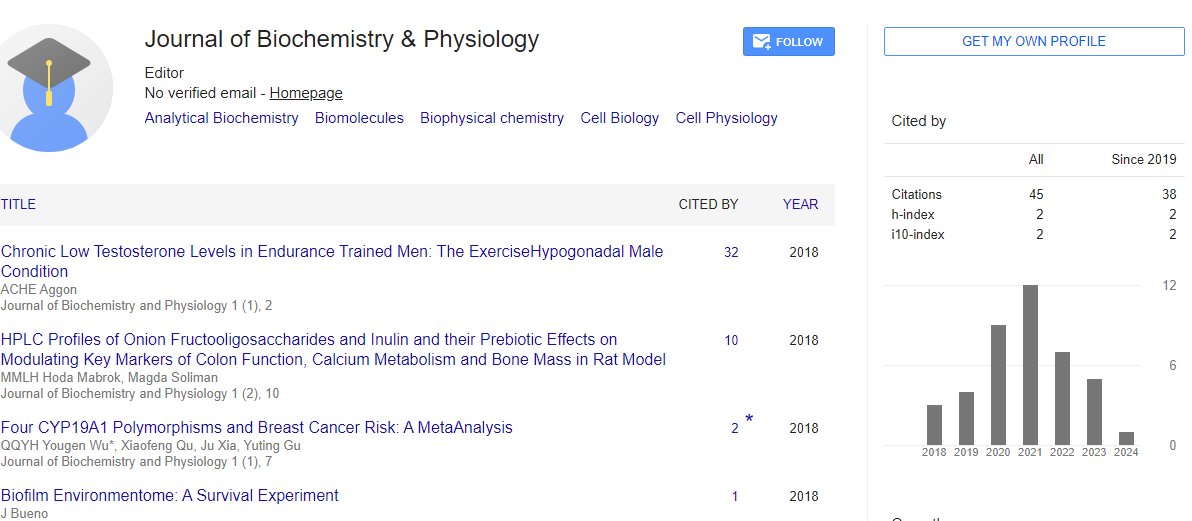Perspective, J Biochem Physiol Vol: 6 Issue: 1
Significance of Biogenesis and Organelle Inheritance
Keyan Kim*
Department of Environmental and Occupational Health, Sichuan University, Sichuan, China
*Corresponding Author: Keyan Kim
Department of Environmental and Occupational Health
Sichuan University, Sichuan, China
E-mail: keyankim12@gmail.com
Received date: 20-Feb-2023, Manuscript No. JBPY-23-95817;
Editor assigned date: 22-Feb-2023, PreQC No. JBPY-23-95817 (PQ);
Reviewed date: 09-Mar-2023, QC No JBPY-23-95817;
Revised date: 16-Mar-2023, Manuscript No. JBPY-23-95817 (R);
Published date: 23-Mar-2023, DOI: 10.4172/jbpy.1000126
Citation: Kim K (2023) Significance of Biogenesis and Organelle Inheritance. J Biochem Physiol 6:1.
Description
Cells are the fundamental units of life, and within them, organelles play important roles in maintaining cellular function. Organelles are specialised structures that carry out specific functions within the cell, analogous to organs in a multicellular organism. Two important aspects of organelles are their inheritance and biogenesis, which are vital for the proper functioning of cells and the transfer of genetic information from one generation to the next. Organelle inheritance refers to the process by which organelles are passed down from one generation of cells to the next during cell division. Organelles, such as mitochondria and chloroplasts, possess their own genetic material in the form of DNA, which encodes some of the proteins necessary for their function. This unique genetic makeup raises intriguing questions about how organelles are inherited and how they contribute to the overall characteristics of a cell. One of the best-known examples of organelle inheritance is the inheritance of mitochondria, which are often referred to as the "powerhouses of the cell." Mitochondria are responsible for generating energy in the form of ATP through a process called oxidative phosphorylation. They are believed to have originated from symbiotic relationships between early eukaryotic cells and prokaryotic cells. Over time, this symbiotic relationship led to the evolution of mitochondria as organelles within eukaryotic cells, but they still retain their own DNA and the ability to replicate independently.
During cell division, mitochondria are randomly distributed into daughter cells, resulting in a mixture of old and newly synthesised mitochondria in each cell. This phenomenon, known as heteroplasmy, can lead to variability in mitochondrial DNA content and function among cells within the same organism. The exact mechanisms of organelle inheritance are still being actively researched, and it is believed that multiple factors, including the cytoskeleton, motor proteins, and membrane dynamics, play roles in the distribution of organelles during cell division. Organelle biogenesis refers to the process by which organelles are synthesised and assembled within a cell. It involves the coordinated expression of genes in both the nuclear genome and the organelle genome, as well as the import of proteins and lipids from other cellular compartments. The biogenesis of organelles is tightly regulated and relies on complex protein-protein interactions, membrane dynamics, and cellular signalling pathways.
For example, the biogenesis of mitochondria requires the expression of both nuclear genes and mitochondrial genes. Nuclear genes encode proteins that are imported into mitochondria and are essential for their function, while mitochondrial genes encode some of the proteins necessary for oxidative phosphorylation. The coordinated expression of these genes is critical for the proper assembly and function of mitochondria. Disruptions in this process can result in mitochondrial dysfunction, which has been implicated in various diseases, including neurodegenerative disorders, metabolic diseases, and cancer. Similarly, chloroplasts, which are organelles found in plants and some algae, are responsible for photosynthesis, the process by which light energy is converted into chemical energy. Chloroplasts also possess their own DNA and are believed to have originated from symbiotic relationships between early eukaryotic cells and cyanobacteria. The biogenesis of chloroplasts involves the coordination of nuclear and chloroplast-encoded genes, as well as the import of proteins from other cellular compartments.
 Spanish
Spanish  Chinese
Chinese  Russian
Russian  German
German  French
French  Japanese
Japanese  Portuguese
Portuguese  Hindi
Hindi 